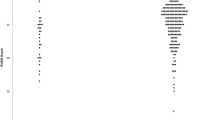Abstract
Purpose
Hip fracture treatment is controversial, with high complication rates. An algorithm for hip fracture surgery has shown reduced reoperation rates, but choice of implant is based on the commonly used fracture classifications, which were previously evaluated to be unreliable. The purpose of this study was to investigate the reliability of the algorithm.
Methods
From two hospitals, four observers (orthopaedic consultant, fellow, resident and intern) used the algorithm to classify into 15 hip fracture types [Garden type I–IV femoral neck including posterior tilt, vertical femoral neck, basocervical and Arbeitsgemeinschaft für Osteosynthesefragen (AO)-31 A1.1 to A3.3 trochanteric fractures] and to choose between five surgical procedures [parallel implants, prosthesis, two-or four-hole sliding hip screw (SHS) and intermedullary (IM) nail]. After individual assessment, each hospital made a consensus decision. Observations were performed twice, ten weeks apart, on pelvic, anteroposterior (AP) and axial X-rays from 100 consecutive patients.
Results
For fracture classification, mean kappa values were 0.60 for intra and 0.62 for interobserver variation, with interobserver variation between hospitals at 0.65. For posterior tilt, mean intraclass correlation coefficient was 0.91 for intra and 0.87 for interobserver variation. For choice of implant type, mean kappa values were 0.86 for both intra and interobserver variation. The two hospital consensus decisions chose same implant in 91 of 100 patients, giving a kappa value at 0.88.
Conclusion
Although hip fracture classification confirmed to be somewhat unreliable in this study, posterior tilt measurement and subsequent choice of implant type by the algorithm was found to be reliable, which opens up the possibility for a more standardized treatment of hip fracture patients between hospitals.

Similar content being viewed by others
References
Palm H, Krasheninnikoff M, Holck K, Lemser T, Foss NB, Jacobsen S, Kehlet H, Gebuhr P (2012) A new algorithm for hip fracture surgery. Acta Orthop 83:26–30
Garden RS (1961) Low-angle fixation in fractures of the femoral neck. J Bone Joint Surg Br 43:647–663
Orthopaedic Trauma Association Classification, Database and Outcomes Committee (2007) Fracture and dislocation classification compendium-2007. J Orthop Trauma 10:Suppl.
Landis JR, Koch GG (1977) The measurement of observer agreement for categorical data. Biometrics 33:159–174
van Embden D, Rhemrev SJ, Genelin F, Meylaerts SAG, Roukema GR (2012) The reliability of a simplified Garden classification for intracapsular hip fractures. Orthop Traumatol Surg Res 98:405–408
van Embden D, Rhemrev SJ, Meylaerts SAG, Roukema GR (2010) The comparison of two classifications for trochanteric femur fractures: The AO/ASIF classification and the Jensen classification. Injury 41:377–381
Pervez H, Parker MJ, Pryor GA, Lutchman L, Chirodian N (2002) Classification of trochanteric fracture of the proximal femur: a study of the reliability of current systems. Injury 33:713–715
Schipper IB, Steyerberg EW, Castelein RM, van Vugt AB (2001) Reliability of the AO/ASIF classification for pertrochanteric femoral fractures. Acta Orthop Scand 72:36–41
Parker MJ (2009) Results of internal fixation of Pauwels type-3 vertical femoral neck fractures. Letter to the editor with reply from Haidukewych GJ. Joint Surg Am 91:490–491
van Embden D, Roukema GR, Rhemrev SJ, Genelin F, Meylaerts SAG (2011) The pauwel classification for intracapsular hip fractures: is it reliable? Injury 42:1238–1240
Mallick A, Parker MJ (2004) Basal fractures of the femoral neck: intra or extracapsular. Injury 35:989–993
Massoud EIE (2010) Fixation of basicervical and related fractures. Int Orthop 34:577–582
Palm H, Gosvig KK, Krasheninnikoff M, Jacobsen S, Gebuhr P (2009) A new measurement for posterior tilt predicts reoperation in undisplaced femoral neck fractures. Acta Orthop 80:303–307
Bjorgul K, Novicoff WM, Saleh KJ (2011) Learning curves in hip fracture surgery. Int Orthop 35:113–119
Alho A, Benterud JG, Roenningen H, Hoeiseth A (1991) Radiographic prediction of early failure in fermoral neck fracture. Acta Orthop 62:422–426
Acknowledgements
We thank biostatisticians Janne Petersen and Steen Ladelund, Clinical Research Center, Hvidovre Hospital, for statistical support.
Conflict of interest
None.
Author information
Authors and Affiliations
Corresponding author
Rights and permissions
About this article
Cite this article
Palm, H., Posner, E., Ahler-Toftehøj, HU. et al. High reliability of an algorithm for choice of implants in hip fracture patients. International Orthopaedics (SICOT) 37, 1121–1126 (2013). https://doi.org/10.1007/s00264-013-1831-7
Received:
Accepted:
Published:
Issue Date:
DOI: https://doi.org/10.1007/s00264-013-1831-7




